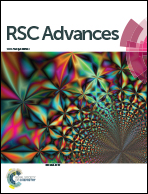Selective strontium adsorption using synthesized sodium titanate in aqueous solution
Abstract
Amorphous sodium titanates were synthesized using a mid-temperature sol–gel method for evaluation as selective adsorbents of strontium in the presence of cesium or metal cations (Al3+, Mg2+, Ca2+, and Mn2+) from aqueous solution. Synthesized sodium titanate showed high adsorption capacity and selectivity for strontium. The maximum adsorption capacity of strontium by sodium titanate was 193.93 mg g−1 in aqueous solution containing an initial concentration of 5 mM (438.60 mg L−1) strontium and 5 mM (666.67 mg L−1) cesium, and this sodium titanate removed 99.9% of the strontium and 40.67% of cesium from an aqueous solution that had an initial concentration of 1.14 mM (100 mg L−1) strontium and 0.75 mM (100 mg L−1) cesium. Strontium adsorption by synthesized sodium titanate followed pseudo-second-order kinetics and a generalized Langmuir isotherm model, and reached an adsorption equilibrium within 1 h with high adsorption capacity at equilibrium. Adsorbed strontium onto synthesized sodium titanate showed the behavior of forming a strontium titanate structure with a titanate frame via surface precipitation.



 Please wait while we load your content...
Please wait while we load your content...